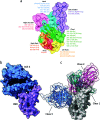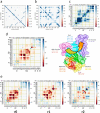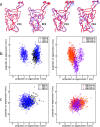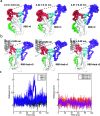Allosteric Signal within the Receptor-Binding Domain of the SARS-CoV-2 Spike Protein Mediated by a Class 3 Monoclonal Antibody Revealed through Molecular Dynamics Simulations and Protein Residue Networks
- PMID: 38313482
- PMCID: PMC10831861
- DOI: 10.1021/acsomega.3c07947
Allosteric Signal within the Receptor-Binding Domain of the SARS-CoV-2 Spike Protein Mediated by a Class 3 Monoclonal Antibody Revealed through Molecular Dynamics Simulations and Protein Residue Networks
Abstract
This study investigated the allosteric action within the receptor-binding domain (RBD) of the SARS-CoV-2 spike protein caused by class 3 monoclonal antibody (mAb) binding. As the emergence of SARS-CoV-2 variants has raised concerns about the effectiveness of treatments by antibodies, targeting the highly conserved class 3 epitopes has become an alternative strategy of antibody design. Simulations of explicitly solvated RBD of the BA.2.75 omicron subvariants were carried out both in the presence and in the absence of bebtelovimab, as a model example of class 3 monoclonal antibodies against the RBD of the SARS-CoV-2 spike protein. The comparative analysis showed that bebtelovimab's binding on two α helices at the epitope region disrupted the nearby interaction network, which triggered a denser interaction network formation on the opposite side of the receptor-binding motif (RBM) region and resulted in a "close" conformation that could prevent the ACE2 binding. A better understanding of this allosteric action could lead to the development of alternative mAbs for further variants of concern. In terms of computational techniques, the communicability matrix could serve as a tool to visualize the effects of allostery, as the pairs of amino acids or secondary structures with high communicability could pinpoint the possible sites to transfer the allosteric signal. Additionally, the communicability gain/loss matrix could help elucidate the consequences of allosteric actions, which could be employed along with other allostery quantification techniques in some previous studies.
© 2024 The Authors. Published by American Chemical Society.
Conflict of interest statement
The authors declare no competing financial interest.
Figures






Similar articles
-
Defining a de novo non-RBM antibody as RBD-8 and its synergistic rescue of immune-evaded antibodies to neutralize Omicron SARS-CoV-2.Proc Natl Acad Sci U S A. 2023 Dec 26;120(52):e2314193120. doi: 10.1073/pnas.2314193120. Epub 2023 Dec 18. Proc Natl Acad Sci U S A. 2023. PMID: 38109549 Free PMC article.
-
Examining Functional Linkages Between Conformational Dynamics, Protein Stability and Evolution of Cryptic Binding Pockets in the SARS-CoV-2 Omicron Spike Complexes with the ACE2 Host Receptor: Recombinant Omicron Variants Mediate Variability of Conserved Allosteric Sites and Binding Epitopes.bioRxiv [Preprint]. 2023 Sep 12:2023.09.11.557205. doi: 10.1101/2023.09.11.557205. bioRxiv. 2023. PMID: 37745525 Free PMC article. Preprint.
-
Exploring Conformational Landscapes and Cryptic Binding Pockets in Distinct Functional States of the SARS-CoV-2 Omicron BA.1 and BA.2 Trimers: Mutation-Induced Modulation of Protein Dynamics and Network-Guided Prediction of Variant-Specific Allosteric Binding Sites.Viruses. 2023 Sep 27;15(10):2009. doi: 10.3390/v15102009. Viruses. 2023. PMID: 37896786 Free PMC article.
-
Susceptibility of SARS-CoV-2 Omicron Variants to Therapeutic Monoclonal Antibodies: Systematic Review and Meta-analysis.Microbiol Spectr. 2022 Aug 31;10(4):e0092622. doi: 10.1128/spectrum.00926-22. Epub 2022 Jun 14. Microbiol Spectr. 2022. PMID: 35700134 Free PMC article.
-
Physicochemical effects of emerging exchanges on the spike protein's RBM of the SARS-CoV-2 Omicron subvariants BA.1-BA.5 and its influence on the biological properties and attributes developed by these subvariants.Virology. 2023 Oct;587:109850. doi: 10.1016/j.virol.2023.109850. Epub 2023 Jul 28. Virology. 2023. PMID: 37562286 Review.
Cited by
-
Replication Features of SARS-CoV-2 and Advantages of Targeting S Protein with Aptamers to Block Viral Entry.ACS Omega. 2025 Apr 21;10(16):15840-15851. doi: 10.1021/acsomega.4c10933. eCollection 2025 Apr 29. ACS Omega. 2025. PMID: 40321580 Free PMC article. Review.
References
LinkOut - more resources
Full Text Sources
Research Materials
Miscellaneous
